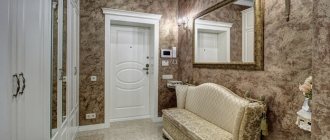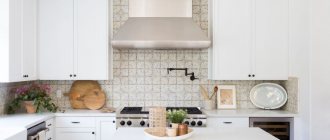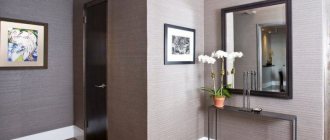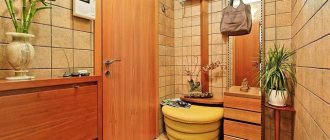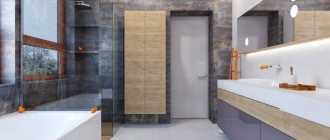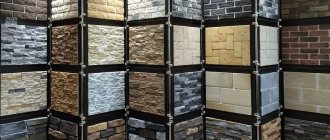Advantages and disadvantages of tiling flooring
In addition to dirt and water, sand and salt get into the corridor.
They are frequent visitors, especially in winter. Therefore, special requirements are placed on the flooring in the hallway. In addition to strength, water resistance and durability are essential.
It is believed that wooden floors are an almost ideal option. And they are preferred for the naturalness and environmental friendliness of the coating. But no matter how carefully the surface of the board is treated, sooner or later it will become unusable due to constant contact with water.
Linoleum is also popular. It is washable and waterproof. With proper care it lasts a long time. But this material is easily deformed. And in the corridor, the load on the floor increases, especially in winter.
And only tiles meet all the above requirements. In addition, it has many advantages:
- The smooth surface is easy to clean from dirt.
- Not at all afraid of water.
- Withstands heavy loads and even impacts.
- The tiles are completely fireproof.
- Can cool the room in hot weather.
- The damaged part of the floor can be easily replaced.
- Harmless to humans.
The shortcomings of the material are minor and can be easily eliminated. The main highlight is weak sound insulation, but in the hallway this is not as important as in the bedroom. Surface may be slippery.
In addition, the material can be easily combined with others. For example, tiles and laminate go well together in one room. True, the room should not be small.
Where is it used?
Porcelain stoneware is an extremely durable, wear-resistant and versatile material, which is why it is used:
- in cladding the facades of industrial and commercial buildings, as well as residential complexes;
- in facing porches and steps of residential buildings and commercial buildings;
- for laying floors both in residential premises and in industrial premises, for example, in warehouses, where the floor covering is exposed to pressure from equipment;
- for wall cladding during apartment renovations.
Tiles can be purchased in bulk for large-scale projects, for example, the construction of a residential complex, or by individuals for apartment renovation or reconstruction of a private house.
Criteria for choosing tiles for the hallway
When choosing a floor covering, it is always necessary to take into account the specifics of the room. In the corridor there is high load on the floor - heels, dirty shoes and high traffic. Not all materials can withstand such conditions.
Of course, you can limit yourself to ordinary linoleum with a high wear resistance class. But what if you want something more sleek and elegant? And this is where modern floor tiles come to the rescue.
Consider these nuances:
- Choose a material that is not afraid of mechanical damage. Including abrasive influences, detergents, household chemicals;
- Seal the joints to prevent dirt and water from accumulating between them. A special waterproof putty will come to the rescue;
- Don't forget about dirty shoes when choosing a tile color. And then the corridor will always be clean and well-groomed;
- Remember safety. Choose collections with a special non-slip coating or textured tiles, which you can safely walk on in wet shoes after rain and snow.
Distinguishing marks
If it is not possible to arrange everything in such a way that it is visible from the hallway, you need to highlight it yourself. In the case of the living room, for example, you can add various characteristic decorations on the door or above the door. A very fashionable solution is to apply appropriate symbols above the doors that describe the room.
Methods for laying tiles in the hallway
The following techniques are used for installation:
- The usual one is used for large spaces, and the best effect is obtained by combining tiles of different colors.
- Offset laying is suitable for rectangular corridors. Tiles of different colors look attractive. This is how a coating is laid that imitates natural materials.
- Narrow rectangular tiles, including those similar to parquet, are laid using the herringbone method.
- Parquet laying is used to lay out ceramic tiles that imitate a wooden surface.
- The modular installation begins with an ornament in the center of the corridor and continues along its perimeter.
Choose a grout that prevents dirt and water from accumulating in the seams. Make the joints dark to make them easier to clean.
A diagonal with non-parallel walls visually expands a narrow corridor.
To imitate carpets, tiles with a variety of ornaments and patterns are used.
The tiles are combined with other finishing materials, and the edges of the cladding adjacent to the corridor need to be decorated.
Details
Often, when decorating, people make very typical mistakes, which greatly affect the overall psychological background of the room. It's all about the aggressive pieces of furniture and decorations that may be present.
At the same time, their presence is not obvious to the owner of the house, because he carefully selected everything based on functionality. However, not only the functionality of the furniture plays an important role, but also its size and color scheme.
In small hallways in 2022, it is generally not recommended to place dark furniture, at best some light wood shade. It is recommended to use cream tones, they better set the mood in a positive way.
Aggressive decorations may include large dark paintings or other elements. Even a banal pattern on wallpaper can be perceived in two ways by different people.
Types of tile coverings
Ceramic tiles
This is exactly the type of coating that is implied by the word “tile”. Floor tiles in a hallway differ in many ways from those used in a kitchen or bathroom. It has a much higher density, thickness and grain size. Thanks to these qualities, the material is able to withstand shock and pressure.
The average price of ceramic tiles is from 200 to 1000 rubles per square meter. The price depends on the manufacturer, the newness of the collection and the design. Many companies make patterned tiles from wood or stone, but ceramic tiles remain the most popular flooring option.
Interior tiles look simple, but will last a long time due to increased safety
Porcelain tiles
Porcelain tiles have an excellent appearance and are very practical due to their durability. According to the Friedrich Mohs scale, the material has a load resistance rating of 7.
Manufacturers produce tiles of different thicknesses. It ranges from 7 to 30 mm. In addition, the material easily tolerates frequent temperature changes, which makes it popular for rooms close to the street.
In addition to high strength, the tiles have excellent chemical resistance. The exception is hydrofluoric acid, which corrodes granite. In addition, the material is valued for its ability to eliminate any surface defects when installed correctly.
Vinyl
Vinyl tiles are made from rubberized plastic and stone chips are added to the mixture. Advantages of vinyl: no seams during installation, increased strength and high resistance to mechanical damage.
Vinyl tiles seamlessly replace natural materials in an open area
Quartzvinyl
Tiles are made by combining different materials. In essence, this is a modern PVC surface. Thanks to its excellent wear resistance, it is designed for places with large crowds of people and high traffic.
The tile consists of four layers:
- The first one is made of polyvinyl chloride. Provides reliable attachment to the surface.
- The second one is made of fiberglass, which increases its load-bearing capacity.
- The third strengthens. Made from quartz and vinyl.
- The fourth layer is protective. It consists of polyurethane. It also performs a decorative function.
The material has excellent soundproofing properties compared to others. It has a number of advantages. For example, it is perfect for “warm floors”. Although artificial materials are used in the manufacture of tiles, they are completely safe for humans, as they remain environmentally friendly.
Multilayer tiles
It consists of several layers. The first is thickened polyvinyl chloride, the second is a ceramic base with the addition of granite particles, then a layer of pigmented and green grass. The obvious advantage of such tiles is its high strength. In addition to this, it is not as cool as regular ceramic tiles, but is a bit like laminate.
PBX
Polyvinyl chloride is linoleum that is laid in small parts. Visually, linoleum goes well with ceramic tiles. The coating is soft and easy to install. The natural advantage of linoleum is its low price, but there is also an obvious drawback - it quickly breaks from mechanical damage.
High-quality linoleum replaces ceramic tiles in an open area
Clinker
Clinker is a small brick that has a rectangular shape and is fired using a special technology. Sometimes it is glazed and uneven. Clinker is used not only on walls, but also on open floors.
Clinker brick highlights a small area in the house or hallway
Kinds
Square tiles
The characteristics of this option are virtually identical to the diamond-shaped elements. These tiles are also made with a glossy surface or can look like leather. It can come with gold inserts, as well as seam-shaped details. The standard dimensions of such large-type products are 200x200mm, and small ones - 100x100mm.
Mosaic pattern
The versatility of quadrangular tiles makes it possible to create various original patterns in the form of stars, a grid or three-dimensional images. For such designs, special inserts made of metal, glass, wood and other suitable materials are provided.
Paving slabs
Since this article is about a unique finish made of diamond-shaped tiles, we cannot ignore the common material for decorating sidewalks. In addition to a durable, wear-resistant coating, such models are capable of creating an original pattern that perfectly complements the design surrounding them.
A variety of diamond-shaped paving slabs
Today there are no clear requirements put forward by the state for the production of tiles, therefore each manufacturer provides products created using its own technology. As a rule, sizes vary from 15x25cm to 19x33cm. For a pedestrian sidewalk, the thickness of the stones can be from 4 cm, and for highways it often reaches 7 cm.
There are also individual products produced in China that are designed to facilitate the installation process. These are kind of “halves” of a diamond:
- The transverse half is an isosceles triangle, the upper corner of which is sharper than the side ones.
- The longitudinal half is a triangle with a blunt apex.
Despite its purpose (to reduce the cost of installation by eliminating sawing of tiles), such products are much more expensive, and therefore are rarely used in work.
As for coloring, it can cover only the upper (front) part of the stone up to 3 cm thick, and also completely color the diamond. There are more than 30 different shades on the market.
The border that decorates tiled sidewalks and courtyards also comes in different colors. It may match the color of the tile or differ from it. Its role depends on this - it can only limit the sides of the covering, merging with it, or it can serve as a separate element of the ornament, standing out against the general background.
Sizes and shape of tiles
Available in various sizes and shapes. With the right combination, you can achieve a visual expansion of the corridor or correct errors after renovation. The shape of the tiles is square, rectangular, hexagonal, and curly.
Rough tile installation takes less time, but fewer joints provide a cleaner finish. Small tiles reduce the amount of trimming work and make small patterns attractive.
Based on the technical and decorative characteristics of the material, the problems of a specific room and its arrangement are solved.
Expansion of space in a narrow corridor is achieved:
- Striped tiles with alternating light and dark lines;
- Finished with large sized tiles in shades of blue, gray, brown;
- Using bright glossy tiles;
- Using the same materials at the intersection of the corridor with other rooms;
- Zoning the space through a combination of different materials;
- A combination of black and white tiles or highlighting light and dark areas.
Techniques for arranging spacious rooms:
- Use of figured and metlakh tiles in the form of a mosaic;
- Application of large tiles with a three-dimensional pattern;
- Laying carpets with mosaics on the sides in the center of the room.
In the hallway, tiles of higher density and resistance to detergents are used. The place for meeting guests is decorated in the form of a colorful carpet or ornamental motifs.
Decor with imitation wood, laminate, marble, granite, onyx will add originality to the interior, and geometric patterns will add aristocracy.
Based on the characteristics of each type of tile and decorative effect, it is necessary to determine its position on the surface.
Useful tips
It is impossible to ignore such interesting aspects as making the living room more comfortable, modern and pleasing to the eye.
- Warm floors will be an excellent addition and will create a pleasant atmosphere for guests - slippers, colds, foot discomfort (cold) will be a thing of the past.
- Fresh flowers, large and beautiful, in pots or flowerbeds made of tiles will fit perfectly into any interior. They will serve as a freshener, air purifier and look luxurious.
- If there is a staircase or borders in the living room, they should definitely be supplemented with either decorative or designer tiles. Although it is expensive, it can add incredible chic to the interior!
These three small, at first glance, subtleties have a wide meaning, using them in the living room will only be a plus!
Palette of shades
By placing light tiles in the hallway, you can visually move the room away. A snow-white palette, beige, grayish shades, walnut and pastel colors are excellent options for this. But such tiles on the wall require constant attention, as dirt is immediately noticeable.
However, this feature is also characteristic of a dark floor, when it is very smooth and even small scratches are visible. In addition, such a shade can significantly limit an already small space.
The best options for floor tiles in the hallway are shades of muted tones.
Pay attention to the color. Any cold and dark shades visually contribute to the removal of objects. The property of light colors is to bring them closer together.
Black
A hallway with a black floor should be spacious enough, otherwise the color will narrow the space even more. On this type of floor the damage is most noticeable. Therefore, black tiles are often combined with white tiles, arranged in a checkerboard pattern.
Gray
The most popular and winning option for the hallway, it harmonizes with any wall design. Scratches and dirt are not so noticeable on it.
Beige
Beige belongs to neutral and warm tones. Such a floor in the hallway would rather serve as a backdrop for decoration than attract attention.
Blue
The choice is controversial, which is why it is more common in two-tone floors.
In the photo, a contrasting blue border favorably complements the ornament on a white background.
Red
This color in the hallway is often used in combination with white or as part of ornaments in muted tones - pink, burgundy.
White
Glossy white looks elegant and can be combined with any shade. Bright tiles reflect light and expand the space. But for a hallway this is an excessively slippery coating, and on products with a rough surface and light grouting, the dirt will be more noticeable.
The photo shows white tiles at the entrance, combined with the walls and light wood.
What to avoid
Regardless of the size and type of hallway, there is a basic set of rules that must be followed in order to create the most comfortable conditions.
In 2022, it is considered unacceptable to place a mirror in front of the front door. This is due more to the psychological factor of a person. With this arrangement, the person will feel like something is approaching him; he will try to keep track not only of his own actions, but also of the actions in the mirror.
This is significantly stressful and does not help you relax after a hard day. If you need to hang a mirror, it is best to do it from the side, in the form of a small mirror above the table.
Note!
New curtain designs for 2022: TOP-150 photos of exclusive solutions using modern style and designNew tulle items 2022 | Types of curtains and tips for using different types of tulle in the interior (180 photos)
- New curtains for the kitchen in 2022: examples of stylish and beautiful curtain models and tips for their use in interior design (180 photos)
What tiles look like in different styles
Thanks to its variety, ceramic coating is suitable for all styles.
Modern
Style is based only on practicality. But don’t forget about the attractive component. The design should look good and fit the overall concept of the room.
Based on practical decisions, only the most affordable materials are selected. Also for the same reason, a dark design option is more justified. But finishing in a light style is allowed if the concept does not require it. There are no restrictions on the palette.
For finishing, you can choose monolithic blocks or with a clear geometric pattern. It is allowed to dilute large elements with small inserts. The essence of the idea is the unification of opposites.
For modern style, any experiments are acceptable. You can abandon generally accepted norms and lay out the floor with small light tiles, surrounding it with dark walls. An interesting option with a black floor and white walls. You can try to assemble a multi-colored mosaic on the surface. The main thing when finishing is to be guided by practicality.
Minimalism
For minimalism, choose one tile in a basic shade. The rigor and simplicity of minimalism should also be shown in the flooring.
Loft
Thanks to its variety, ceramic coating is suitable for all styles.
Lofts prefer (often distressed) faux wood floors in the hallway. Minimalism is characterized by tiles with a laconic pattern: white, gray, with the texture of concrete. Floor products imitating natural stone emphasize the sophistication of the classics.
The photo shows a loft-style hallway with black and white patterned tiles.
Provence
For a stylish interior, a light floor made of small bricks and figured fragments is suitable. This design takes on the features of lightness and romanticism inherent in the casual style. If you don’t want to focus attention on the floor, take tiles that imitate existing parquet in a light shade.
Scandinavian
In the Scandinavian style, patchwork is now more popular. Adherents of high-tech choose a modern design for the hallway floor, emphasizing the smooth lines of furniture and decor.
If you adhere to traditions, the style involves the use of a large number of white surfaces. This is due to the fact that in Scandinavian countries there is no sun for more than half the days of the year. Therefore, light glossy surfaces with a minimum of ornaments and designs are popular.
The ability to diffuse low light is important in small, cramped hallways. Therefore, in narrow hallways the use of white Scandinavian style is completely justified.
But you can give preference to light brown tones. In this case, the tiles are selected to imitate wood. The floors are tiled with brown tiles, and one of the walls is tiled in the same color. It is best to take the one with furniture. The remaining surfaces remain as light as possible.
Classic
The classic interior uses light colors, glossy surfaces and natural materials. For a stylish setting, choose marble tiles with gold or silver embellishments, bold patterns and a vibrant appearance.
Recommendations for design
When starting to develop the idea of a white bathroom, people often encounter the problem of the interior being overloaded with details, furnishings, or too intrusive ornamentation. In this case, harmony can be achieved if you follow the rule of minimalism.
The main thing here is to follow the advice of experts:
- white perfectly reflects light, so lighting in the bathroom needs to be given special importance; the location of the lamps, the power and shape of the lampshades must be taken into account, especially when the finish is embossed or with a pattern;
- by adding a few accessories, you can absolutely change the perception of the whole picture;
- it is not necessary to insert color accents on all planes; a bright spot on one wall will be enough;
- if you plan to use a mosaic, you will have to select the shade as clearly as possible, without getting into it, the worker risks compromising the integrity of the cladding;
- colored or dark grout can be used only as a last resort, for example, if there is a colored pattern;
- large tiles will not fit into a cramped bathroom; the smaller the room, the smaller the white tiles should be;
- texture or change in size must be used at least once; covering the entire surface with the same type of material will be inexpressive.
An inclusion of elements that match the color, shape, and texture will look harmonious: decorative soap dishes, colored bottles, unusual taps or shower heads, specially shaped mirrors, lamps or lighting under the mirror. Lace and aprons with accents will dilute the atmosphere, a chocolate bar will look appetizing and well-made, and woody contrasts will look incredibly stylish. Muted blue marble will add marine notes; such inserts will look like niches.
White ceramic tiles for the bathroom, although it looks simple, are actually a complex option that requires calculation of all the details. Adding certain accents and selecting interesting details will make the bathroom interior unique.
You might be interested in:
Tile in the toilet: examples of design and photos of interiors
Printing on ceramic tiles: how to make ordinary tiles more beautiful?
Pool tiles: which one is best to choose?
What is the difference between porcelain tiles and ceramic tiles?
Terracotta tiles: the correct lining of the stove
Rectified tiles: what are they?
Brick-like ceramic tiles: photos of interiors
Do-it-yourself tiles: how to make it yourself?
Combining tiles with other coatings
To zone the space, combinations with other materials are used. In order for the transition from one area to another to be smooth and harmonious, it is necessary to properly design the joints. The seam can be straight or curly, depending on the materials used.
You can combine tiles with parquet, linoleum, and carpet.
The area at the entrance, covered with ceramics, may be higher than the rest of the floor, but not more than 5 cm.
The combination with laminate gives a decorative effect and at the same time divides it into 2 zones: the entrance and the one where you can walk barefoot or in slippers.
Design options for the interface between laminate and tiles:
- A flexible profile is used.
- Decorative flexible strip with a wavy edge.
.
A connecting profile along the edge with carpet and linoleum is also used.
In this case, not so much aesthetics are taken into account as the safety of the structure. A reliable option would be to seal the seam with silicone to match the color of the lining or use a cork condenser.
The floor is selected in the style of the general layout of the house or individually for the hallway. In any case, you must be guided by the features of the style.
Tiles and linoleum
This type of docking is cheaper and less problematic. Linoleum can be cut in different ways, for example, in a wave or in a semicircle. To combine space and eliminate floor differences in the hallway, a metal threshold is usually used.
The photo shows ceramic trim on the threshold and laid linoleum in the rest of the corridor.
Parquet and tiles
Parquet is the most vulnerable floor covering. It is definitely not possible to use parquet flooring in the hallway. It is very soft and scratches easily. Absolutely all objects, including heavy and hard ones, enter the apartment through the front door. Hence the rule:
If you use parquet throughout the apartment, then at the entrance to the corridor you must create a tile area.
The good news is that parquet goes well with level 1 tiles. Both materials are glued together; both do not require a buffer zone at the joint. Thus, the parquet and tiles fit perfectly next to each other, and the seams are filled with mortar.
Some take risks and make the floor in the hallway from natural wood.
Tiles and laminate
Absolutely pointless option. We have already found out that there is no point in using tiles in the entrance area and laminate in the rest of the apartment, because laminate will withstand everything without problems.
The most important thing is that the laminate cannot be joined to the tile level. The tiles are fixed with glue; the laminate must be laid loosely, with gaps in front of the wall. This is an important technological aspect.
Rule: we make the joint in the narrowest place, preferably under the door.
Tiles and laminate don't go together. No matter how hard you try, the joint will look bad.
The grout for the floor in the hallway should be very dark.
If you really want to create a tile island in your hallway, at least make it a normal size to keep dirt out of the joint. It is better to tile the entire area up to the door or arch or not lay it at all.
The best option is to lay either only tiles or only laminate throughout the entire corridor.
Pros and cons of combined flooring
Elegant combination of different materials on the kitchen floor
A popular modern trend is the visual division of the kitchen into a dining area and a cooking area. When solving the problem of combined floors, you should pay attention to the combination of floor coverings.
The main advantages of the combination of materials:
- the opportunity to make the kitchen more comfortable;
- it’s easy to keep the food preparation area clean and have a more aesthetically pleasing and comfortable surface near the dining table;
- proper zoning of the kitchen space;
- practicality and hygiene;
- protection against premature wear of materials in those areas that can withstand maximum load.
The disadvantages of this combination include:
- the difficulty of choosing materials from which a harmonious combination can be obtained,
- the need for additional processing of joints,
- asymmetry of the room with poorly thought out placement of different surfaces.
If combining laminate with traditional porcelain tiles is not difficult, it is necessary to provide for a combination of tiles and linoleum at the stage of leveling the surface.
Basic Rules
When decorating the interior of a hallway in 2022, you need to take simplicity and functionality as a rule. Thus, in appearance it will look quite simple and concise, beautiful and without unnecessary details. However, it will fully perform its function in full.
They try to design fashionable hallways of 2022 in such a way that they reflect not only the entire apartment, but also the space that is located outside it. For example, if the apartment is located in a historical, architecturally beautiful area, an excellent solution would be to add these notes to the design.
The subtleties of laying tiles on wooden floors
Laying tiles on a wooden floor in a hallway is considered a long and complex process. These two materials do not combine well with each other and have different characteristics:
- A tree can change in size under the influence of external factors. As humidity increases, the tree expands. Decreases - the wood shrinks. As a result, the top coating is deformed and cracks may appear;
- Wood floors are more susceptible to deterioration than tile floors. Therefore, it is often necessary to re-dismantle the tile covering;
- The adhesive (water repellent) and tiles prevent air from getting into the wood. It is necessary for the tree to work fully. As a result, the base wears out much faster than expected;
- The tile laid on top of the wood should be as light as possible, otherwise over time it may crack in places under the weight of the tile cladding.
It is strictly forbidden to engage in masonry work on a wooden base if two years have not yet passed after installation. If you rush, the tiles will certainly crack when they shrink.
Features of heated floors
There are certain advantages of having a heated floor under the tiles:
- environmental Safety;
- favorable temperature conditions;
- increased surface area due to the absence of heating radiators;
- The warm tiles feel good on your feet.
The disadvantages include the complexity of the work and the need to carefully level the surface before installation. Also, during repair of the heating system, all tiles will need to be completely removed.
